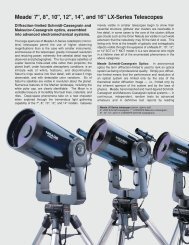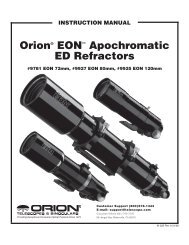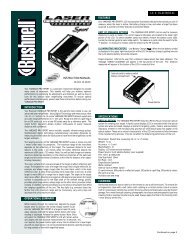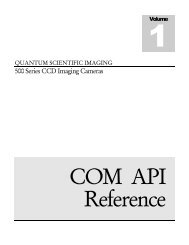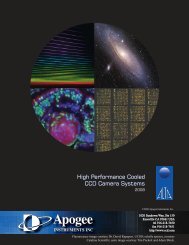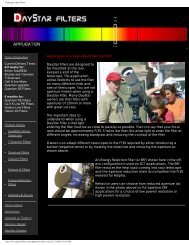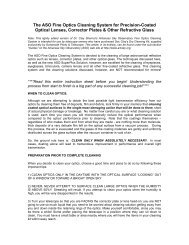INSTRUCTION MANUAL
INSTRUCTION MANUAL
INSTRUCTION MANUAL
You also want an ePaper? Increase the reach of your titles
YUMPU automatically turns print PDFs into web optimized ePapers that Google loves.
To replace the contents of any of the user defined objects, simply save a new object using one of the existing<br />
identification numbers; NexStar will replace the previous user defined object with the current one.<br />
Get RA/DEC - Displays the right ascension and declination for the current position of the telescope.<br />
Goto R.A/ Dec - Allows you to input a specific R.A. and declination and slew to it.<br />
Scope Setup Features<br />
Setup Time-Site - Allows the user to customize the NexStar display by<br />
changing time and location parameters (such as time zone and daylight savings).<br />
Anti-backlash – All mechanical gears have a certain amount of backlash or play<br />
between the gears. This play is evident by how long it takes for a star to move in the<br />
eyepiece when the hand control arrow buttons are pressed (especially when<br />
changing directions). The NexStar's anti-backlash features allows the user to<br />
compensate for backlash by inputting a value which quickly rewinds the motors just<br />
enough to reduce the play between gears. The amount of compensation needed<br />
depends on the slewing rate selected; the slower the slewing rate the longer it will<br />
take for the star to appear to move in the eyepiece. Therefore, the anti-backlash<br />
compensation will have to be set higher. You will need to experiment with different<br />
values; a value between 20 and 50 is usually best for most visual observing,<br />
whereas a higher value may be necessary for photographic guiding.<br />
To set the anti-backlash value, scroll down to the anti-backlash option and press<br />
ENTER. Enter a value from 0-99 for both azimuth and altitude and press ENTER<br />
after each one to save these values. NexStar will remember these values and use<br />
them each time it is turned on until they are changed.<br />
Slew Limits – Sets the limits in altitude that the telescope can slew without<br />
displaying a warning message. By default the slew limits are set to 0º to 90º and will<br />
only display a warning message if an object is below the horizon. However, the<br />
slew limits can be customized depending on your needs. For example, if you have<br />
certain photographic accessories attached to your telescope preventing it from<br />
pointing straight-up, you can set the maximum altitude limit to read 80º, thus<br />
preventing the telescope from pointing to any objects that are greater than 80º in<br />
altitude without warning.<br />
MENU<br />
SCOPE SETUP<br />
SETUP TIME-SITE<br />
ANTI-BACKLASH<br />
AZM POSITIVE<br />
AZM NEGATIVE<br />
ALT POSITIVE<br />
ALT NEGATIVE<br />
SLEW LIMITS<br />
SLEW ALT MAX<br />
SLEW ALT MIN<br />
FILTER LIMITS<br />
ALTMAX IN LIST<br />
ALTMIN IN LIST<br />
DIRECTION BUTTONS<br />
GOTO APPROACH<br />
AZM APPROACH<br />
ALT APPROACH<br />
AUTOGUIDE RATES<br />
AZM RATE<br />
ALT RATE<br />
CORDWRAP<br />
UTILITIES<br />
GPS ON/OFF*<br />
COMPASS *<br />
Observing<br />
Tip!<br />
Filter Limits – When an alignment is complete, the NexStar automatically knows<br />
which celestial objects are above the horizon. As a result, when scrolling through<br />
the database lists (or selecting the Tour function), the NexStar hand control will<br />
display only those objects that are known to be above the horizon when you are<br />
observing. You can customize the object database by selecting altitude limits that<br />
are appropriate for your location and situation. For example, if you are observing<br />
from a mountainous location where the horizon is partially obscured, you can set<br />
your minimum altitude limit to read +20º. This will make sure that the hand control<br />
only displays objects that are higher in altitude than 20º. If you manually enter an<br />
object that is below the horizon using the numeric keypad, the hand control will<br />
display a warning message before slewing to the object.<br />
If you want to explore the entire object database, set the maximum altitude limit to<br />
90º and the minimum limit to –90º. This will display every object in the database<br />
lists regardless of whether it is visible in the sky from your location.<br />
FIND CELEST NORTH<br />
CALIBRATE COMPASS<br />
ALT SENSOR*<br />
FIND ALT SENSOR<br />
CALIBRATE SENSOR<br />
WEDGE ALIGN<br />
LIGHT CONTROL<br />
FACTORY SETTING<br />
PRESS UNDO<br />
PRESS "0"<br />
VERSION<br />
GET ALT-AZ<br />
GOTO ATL-AZ<br />
HIBERNATE<br />
* Indicates features that require<br />
the use of the optional CN16<br />
GPS accessory<br />
Direction Buttons –The direction a star moves in the eyepiece varies<br />
depending on the accessories being used. This can create confusion when guiding<br />
on a star using an off-axis guider versus a straight through guide scope. To compensate for this, the direction of<br />
27




